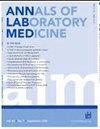Association of ASXL1 and RUNX1 Variants with Splenomegaly in MDS Based on Next-generation Sequencing and Computed Tomography Data: A Retrospective Study.
IF 3.9
2区 医学
Q1 MEDICAL LABORATORY TECHNOLOGY
引用次数: 0
Abstract
Although splenomegaly is typically uncommon in myelodysplastic syndromes (MDS), it is associated with reduced engraftment rates and poor survival outcomes. Despite its clinical significance, the incidence and genetic associations of splenomegaly in MDS remain understudied. To address this, we conducted a retrospective study of 27 patients with MDS at the Veterans Health Service Medical Center in South Korea. Based on computed tomography scan evaluation, splenomegaly was identified in 26% of patients with MDS, and significant associations with variants in ASXL1 (P=0.0089 for null and missense/inframe variants) and RUNX1 (P=0.042 for null variants) were observed, suggesting that these variants are linked to an increased risk of splenomegaly. Notably, one patient with ASXL1 and TET2 variants developed severe splenomegaly (spleen size, 29 cm) following granulocyte colony-stimulating factor (G-CSF) treatment, requiring splenectomy. This case suggests a potential interaction between specific genetic variants and G-CSF sensitivity, potentially exacerbating splenomegaly. Our findings suggest that the incidence of splenomegaly in patients with MDS, including mild cases, is likely underestimated and that ASXL1 and RUNX1 variants increase the risk of splenomegaly. Furthermore, careful monitoring for the development of severe splenomegaly during G-CSF treatment may be warranted in genetically susceptible individuals with MDS.基于下一代测序和计算机断层扫描数据的ASXL1和RUNX1变异与MDS患者脾肿大的关联:一项回顾性研究
虽然脾肿大在骨髓增生异常综合征(MDS)中通常不常见,但它与植入率降低和生存预后差有关。尽管其临床意义,脾肿大在MDS中的发病率和遗传关系仍未得到充分研究。为了解决这个问题,我们对韩国退伍军人健康服务医疗中心的27名MDS患者进行了回顾性研究。基于计算机断层扫描评估,26%的MDS患者发现脾肿大,并且观察到与ASXL1变异(无效和错链/框内变异P=0.0089)和RUNX1变异(无效变异P=0.042)显著相关,表明这些变异与脾肿大风险增加有关。值得注意的是,一名ASXL1和TET2变异患者在粒细胞集落刺激因子(G-CSF)治疗后出现严重脾肿大(脾大小29厘米),需要脾切除术。本病例提示特定基因变异与G-CSF敏感性之间存在潜在的相互作用,可能加剧脾肿大。我们的研究结果表明,MDS患者(包括轻度病例)脾肿大的发生率可能被低估,ASXL1和RUNX1变异增加了脾肿大的风险。此外,在遗传易感的MDS患者中,在G-CSF治疗期间仔细监测严重脾肿大的发展可能是必要的。
本文章由计算机程序翻译,如有差异,请以英文原文为准。
求助全文
约1分钟内获得全文
求助全文
来源期刊

Annals of Laboratory Medicine
MEDICAL LABORATORY TECHNOLOGY-
CiteScore
8.30
自引率
12.20%
发文量
100
审稿时长
6-12 weeks
期刊介绍:
Annals of Laboratory Medicine is the official journal of Korean Society for Laboratory Medicine. The journal title has been recently changed from the Korean Journal of Laboratory Medicine (ISSN, 1598-6535) from the January issue of 2012. The JCR 2017 Impact factor of Ann Lab Med was 1.916.
 求助内容:
求助内容: 应助结果提醒方式:
应助结果提醒方式:


